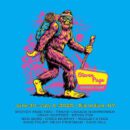Sponsored by TASCAM
Getting a pro-sounding recording in a small club can be difficult. But the invention of handheld digital recorders with built-in mics has made it much easier to get great results. Here are a few tips to get these recorders to sound their best.
Record the Room Sound
You might assume that the output of the front of house mixer would give you the best-sounding recording. But in a smaller space, some instruments get boosted much more than others. So you might end up with a recording with very loud vocals and keyboards and very little drums and guitar. Not to mention missing out on the cheers of your devoted audience.
Using the built-in microphones, you’ll get a much more balanced recording. Place the recorder as close to the best seat in the house as you can. You can set it up on a tripod in calmer environments like jazz or classical venues. In a crowded rock club, your best bet is probably sitting on the front-of-house console on a small tripod stand.
Record the Board Mix Too
If you have a 4-track recorder, like TASCAM’s DR-40 or DR-44WL, you can record the room sound and the board mix at the same time. Just plug a stereo feed from the mixer into the mic/line inputs. Record the mics and the board mix as separate tracks, or mix them together on the recording. If your recorder has a delay setting, delay the board mix so it’s in in phase with the house speakers (1ms per foot.)
Use a Limiter
Once you hit the stage, you probably won’t have much time to check the levels going to the recorder. Set the levels conservatively – it’s much better to have your recording too soft than distorted, especially if you set the format to 24-bit WAV files. To prevent distortion, switch on the recorder’s limiter. This is an extreme compressor that keeps levels from going all the way to distortion. You might also want to try the auto gain setting if you have one.
Dual Recording Can Save Your Mix
Some recorders, like the ones listed above, can record two stereo signals at the same time. But instead of an additional source or input, the second track is recorded at half the level or lower. If the show gets out of control and you overload the recording, you have a safety track as a backup that won’t be distorted.
Performance is Key
Remember that a bad recording of a great performance is much more fun to listen to than a great recording of a poor performance. So start your recording and try to forget about it so you can concentrate on the show. Good luck!
Photo by Sara Molina










